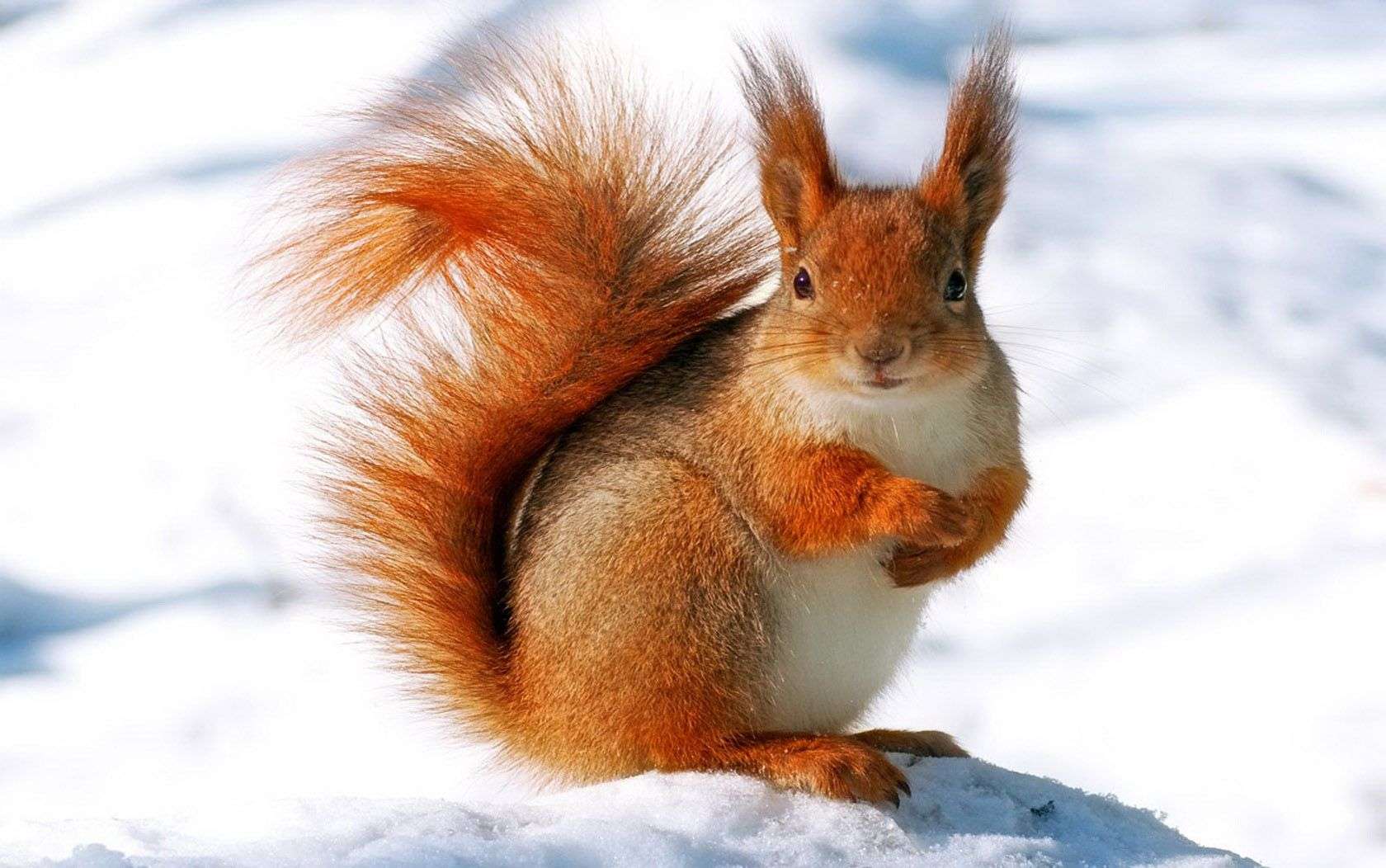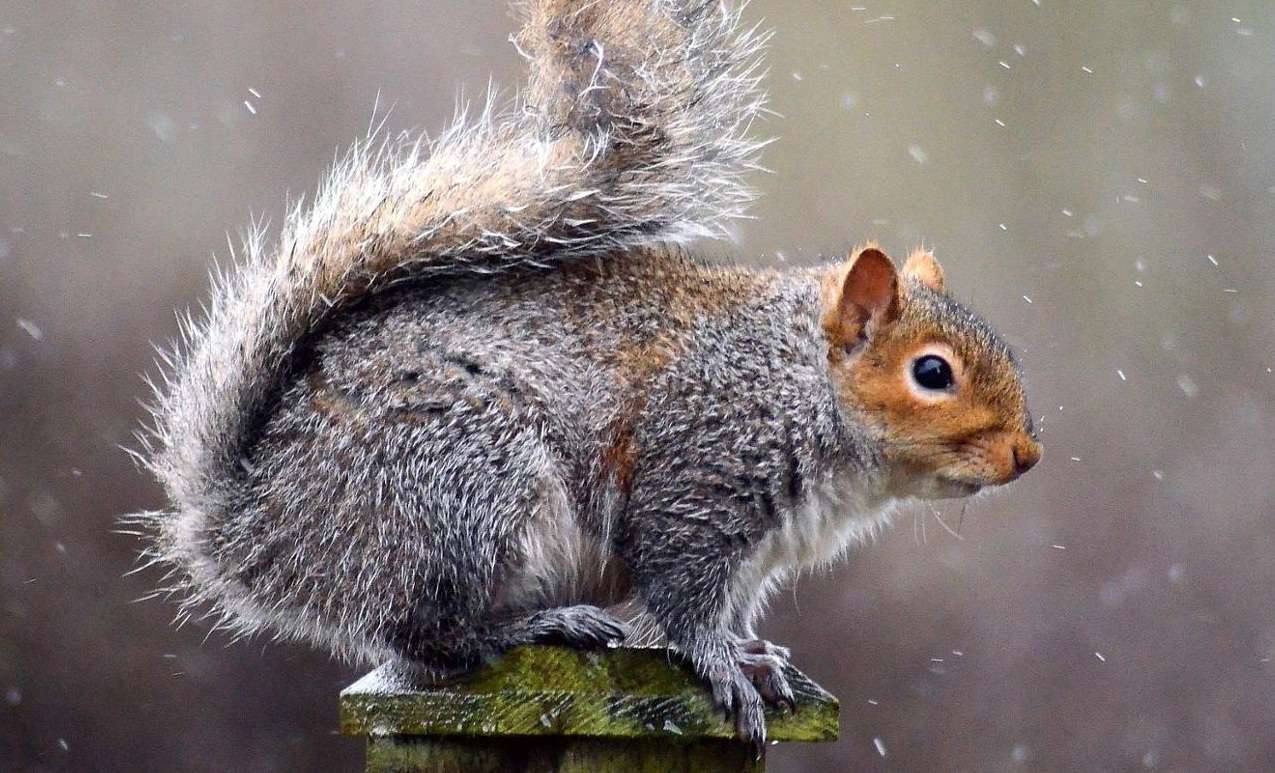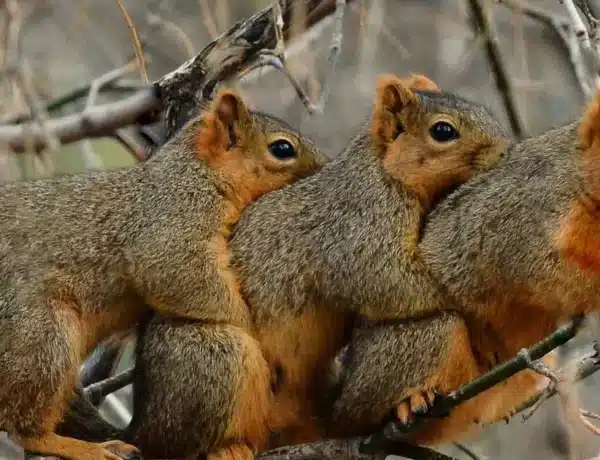Introduction
While their natural habitats range from lush woodlands to urban parks, they all share a common challenge when winter descends the need to maintain their body temperature within a survivable range. Unlike humans, who can bundle up in layers of clothing and retreat to heated shelters, squirrels must rely on a combination of biological adaptations and clever behaviors to brave the cold. In squirrels stay warm in the winter, we will delve into the fascinating world of these resourceful creatures.
Fur coats and specialized metabolism to their strategic nesting habits and food storage techniques, squirrels employ an array of tactics to defy the winter’s chill. Understanding these survival mechanisms not only offers a glimpse into the intricacies of nature but also highlights the resilience of wildlife in the face of harsh squirrels environment challenges. As through the secrets of squirrel survival in winter, we will unravel the mysteries of their thermal regulation, their ability to find food in the snow-covered landscape, and their cozy nests tucked away in tree hollows or bird boxes.

How do squirrels get warm?
Squirrels will share a den in cold weather. Massing bodies together in a single hole/nest helps preserve body heat — there’s warmth in numbers. They also eat huge quantities of food in the fall. This creates not only a food reserve in the body but also an extra thick layer of fat-conserving heat.
The shivers are actually helping the squirrel to keep warm. The vibrations help to generate heat to keep the body warm. In to that squirrels are physically active darting, scurrying or leaping from one place to the next. This constant movement also helps to generate heat and keep squirrels warm.
Insulating Fur: One of the most crucial factors in squirrels’ ability to stay warm is their fur. Their fur coats are specially designed to insulation. They have a double layer of fur, consisting of a dense, soft undercoat and longer, coarse guard hairs. This combination acts as a thermal barrier, trapping a layer of warm air close to their bodies and preventing the cold from penetrating. As winter approaches, squirrels also grow thicker fur, further enhancing their insulation.
Thermoregulation: Squirrels are masters of thermoregulation, the process of maintaining a stable body temperature. They can adjust their metabolic rate to conserve energy and generate heat when needed. During extreme cold spells, they may enter a state of torpor, reducing their metabolic rate, heart rate, and body temperature. This energy-saving mode allows them to survive without expending too much energy.
Nesting: Squirrels are skilled nest builders. They create nests called dreys, typically constructed in tree branches. These dreys are made from a variety of materials, including leaves, twigs, and moss, an insulated and sheltered space. When temperatures drop, squirrels retreat to their dreys, huddling together for warmth. The collective body heat generated by a group of squirrels can significantly raise the temperature within the drey.
Why does a squirrel hibernate in winter?
Unlike in cartoons an populair believe, squirrels do not hibernate. They do however have a winter rest. Meaning they do sleep more in winter, but still wake up everery x days to find food, get a drink, go to the little squirrel room and do some laundry and watch a few shows on telly, befor falling asleep again.
Most squirrels do not hibernate because they don’t need to. A squirrel prepares for the coming winter, gathering enough to last them the entire winter. Thanks to their photo-neuroendocrine system, a squirrel simply knows when the autumn season is wrapping up and begins to prepare for the winter.
Active Lifestyle: One of the primary reasons squirrels don’t hibernate is their active lifestyle. Squirrels are diurnal animals, which means they are most active during the day. They need to forage for food, defend their territories, and engage in various activities to survive. Hibernation, characterized by a state of dormancy and significantly reduced metabolic activity, would be incompatible with their daily routines.
Food Caching: Squirrels are well-known for their ability to hoard food. In preparation for winter, they spend the fall months collecting and burying nuts, seeds, and other food items. These hidden caches serve as their winter food supply. Instead of hibernating, squirrels rely on their food reserves to sustain them through the winter months.
Torpor vs. Hibernation: While squirrels don’t hibernate, they do enter a state of torpor during the coldest periods of winter. Torpor is a temporary state of reduced activity and lowered body temperature. It’s not as deep or prolonged as hibernation. During torpor, a squirrel’s metabolic rate decreases, allowing them to conserve energy. When the weather is extremely harsh, they may spend more time in torpor, becoming less active and staying in their nests.
Do squirrels need to be kept warm?
Whether the baby squirrel is kept inside a box or a cage, a constant heat source must be provided until the squirrel is fully furred and has reached at least 5 weeks of age (longer is better). Once a cold baby squirrel is warmed, keep it warm to prevent hypothermia and death.
Insulating Fur: Squirrels have thick, insulating fur that them with a natural layer of warmth. Their fur consists of a dense, soft undercoat and longer, coarse guard hairs, which trap air close to their bodies and act as effective insulation against cold temperatures. This fur adapts to become even thicker in the winter months, protection.
Thermoregulation: Squirrels are adept at regulating their body temperature. They can adjust their metabolic rate to generate more heat when it’s cold and reduce it when necessary to conserve energy. This flexibility allows them to adapt to changing weather conditions without needing external warmth.
Nesting Behavior: Squirrels are skilled nest builders. They create nests, known as dreys, in trees using leaves, twigs, moss, and other materials. These nests a cozy and insulated shelter where squirrels can retreat during cold weather. Their body heat, combined with the insulation of the drey, helps them stay warm without human intervention.
What is the body temperature of a squirrel?
Mammals are endothermic, meaning they generate enough heat from their own metabolism to maintain a warm body temperature. Like us, an active squirrel at any time of year has a body temperature of about 37 degrees Celsius (95 – 100 oF).
Homeothermic Nature: Squirrels, like most mammals, are homeothermic, which means they can maintain a relatively constant and regulated body temperature. This ability to regulate body temperature allows them to function effectively in a variety of environments and weather conditions.
Species Variation: There are numerous species of squirrels, and their body temperatures can vary slightly among them. For instance, the Eastern Gray Squirrel one of the most common squirrel species in North America, typically maintains a body temperature close to the average mammalian temperature of around 98.6 degrees Fahrenheit (37 degrees Celsius). Other squirrel species may have slightly different temperature ranges.
Environmental Adaptations: Squirrels are known for their adaptability to different climates and weather conditions. During cold weather, they can increase their metabolic rate to generate more body heat and maintain their core temperature within the normal range. In extremely cold conditions, they may enter a state of torpor, which is a temporary reduction in metabolic activity, to conserve energy and maintain their body temperature.
How do squirrels not get hypothermia?
Hibernating mammals, such as ground squirrels, chipmunks and bats, can tolerate extreme hypothermia because their respiratory systems continue to work. Their hearts and lungs still function at Tb’s near 0C, albeit at greatly reduced rates, but they keep the brain and other tissues supplied with oxygen.
Most animals that migrate and hibernate are warm-blooded, but most birds and mammals don’t hibernate or migrate. Instead, they have other mechanisms that protect against harsh winter conditions. Some, such as chipmunks and squirrels, add an extra layer of fat to help insulate their bodies from the cold.
Insulating Fur: One of the most critical defenses against hypothermia is a squirrel’s thick fur. Their fur consists of two layers: a dense, soft undercoat and longer, coarse guard hairs. This combination acts as an efficient insulator by trapping a layer of warm air close to their bodies. As winter approaches, squirrels grow even thicker fur, enhancing their insulation.
Thermoregulation: Squirrels are excellent thermoregulators, meaning they can regulate their body temperature within a narrow range. When exposed to cold temperatures, they can increase their metabolic rate to generate more heat. This metabolic adaptation helps maintain their core temperature. Conversely, during milder weather or periods of rest, they can lower their metabolic rate to conserve energy.
Torpor: While squirrels do not hibernate, they can enter a state of torpor, especially during extremely cold conditions. Torpor is a temporary reduction in metabolic activity. It allows squirrels to conserve energy by becoming less active and reducing their core temperature slightly. This state of torpor helps them survive when food is scarce and temperatures are harsh.
Do squirrels sleep at night?
When Do Squirrels Sleep? Squirrels are just like you. They are active during the day and sleep during the night. This is why you always see them when you’re out enjoying nature on a daytime adventure.
Nocturnal vs. Diurnal: Nocturnal animals, such as owls and raccoons, are active at night and sleep during the day. Diurnal animals, like squirrels, are the opposite; they are active during the day and sleep at night.
Safety and Predation: Sleeping at night a level of safety for squirrels. Many of their natural predators, such as owls, foxes, and domestic cats, are more active at night. By sleeping during the nighttime hours, squirrels reduce their vulnerability to predation.
Daytime Activity: Squirrels have a busy and active lifestyle during the day. They spend their waking hours foraging for food, socializing with other squirrels, and engaging in various behaviors like climbing, jumping, and running. This high activity level requires them to rest and recharge during the night.
Drey or Nest Sleep: Squirrels typically sleep in their nests, known as dreys, during the night. Dreys are well-constructed shelters made from leaves, twigs, moss, and other materials. These nests insulation and protection from the elements, creating a safe and comfortable environment for sleeping.
Can squirrels eat meat?
Do Squirrels Eat Meat. Yes, as we mentioned above, squirrels are omnivorous so it’s not unusual to spot them eating some type of meat. Most commonly, ground squirrels consume meat in their natural habitat. Their diet includes small snakes, lizards, mice, insects, etc.
Herbivorous Diet: Squirrels are classified as herbivores because the majority of their diet is made up of plant materials. Different species of squirrels may have slight variations in their preferences, depending on the availability of food in their specific habitats. The staple of a squirrel’s diet is plant matter, including nuts like acorns, walnuts, and hickory nuts, as well as seeds from a variety of plants.
Occasional Omnivory: While squirrels are primarily herbivorous, they can exhibit omnivorous behavior on rare occasions. This means they may consume small amounts of animal matter, such as insects, small birds’ eggs, or even small vertebrates like baby birds, mice, or insects.
Reasons for Omnivory: Squirrels may turn to animal matter in situations where their regular plant-based food sources are scarce. For example, during times of food scarcity in the winter, some squirrels may supplement their diet with insects or small animals for protein and nutrients.
Can we feed cow milk to baby squirrel?
Never feed the babies any kind of cow’s milk or soymilk. These milks are quick killers for wildlife. Please DON’T use homemade formulas that can be found on the Internet. These are totally inappropriate for squirrels and the long-term effects can be deadly for them.
Digestive System Differences: Squirrels have a specialized digestive system adapted for processing a diet primarily composed of nuts, seeds, fruits, and vegetation. Cow’s milk is not a natural part of their diet, and their digestive system may not be equipped to handle it properly.
Lactose Intolerance: Many mammals, including squirrels, can become lactose intolerant after weaning, which means they lose the ability to digest lactose, the sugar found in milk. Feeding cow’s milk to a baby squirrel can lead to digestive problems, including diarrhea and gastrointestinal discomfort.
Nutritional Imbalance: Cow’s milk does not the appropriate balance of nutrients required for a baby squirrel’s growth and development. Squirrel milk contains a different composition of fats, proteins, and vitamins that are tailored to their needs.
Dehydration Risk: Cow’s milk can lead to dehydration in baby squirrels because it lacks some essential nutrients and electrolytes that they require. Squirrel milk naturally has a higher fat content, which helps the necessary energy for their rapid growth.

Conclusion
In the ways in which squirrels stay warm during the winter months are a testament to the remarkable adaptability and resourcefulness of these small, seemingly ordinary rodents. Nature has equipped them with an array of strategies to thrive in the face of cold and adversity. First and foremost, their fur plays a pivotal role in keeping them warm. Squirrels have a dense coat that acts as both insulation and protection against the elements. It traps a layer of warm air close to their bodies, serving as a natural barrier against the frigid temperatures.
Moreover, the thicker winter fur enhanced insulation compared to their summer coats. Squirrels also have a unique metabolic adaptation that allows them to conserve energy. During extreme cold spells, they enter a state of torpor, which is similar to squirrels hibernating. Their heart rate and body temperature drop significantly, enabling them to conserve vital energy reserves. This energy-saving mode helps them survive when food is scarce and temperatures plummet. Squirrels are expert foragers, and their winter diet consists of nuts and seeds that they have carefully cached during the warmer months.
This extensive food storage strategy ensures a constant supply of nourishment, even when the ground is covered in snow. They can locate these hidden treasures with remarkable precision, thanks to their keen memory and an extraordinary sense of smell. Nesting is another crucial aspect of squirrel survival in winter. They create cozy nests in tree hollows or build intricate dreys high up in the branches. These shelters protection from the cold and wind, offering a safe haven where squirrels can huddle together for warmth. Squirrels employ a combination of physiological adaptations, behavioral strategies, and remarkable instincts to stay warm during the winter.





No Comments